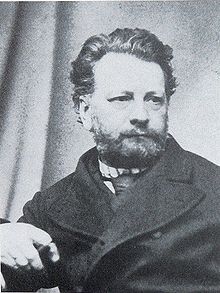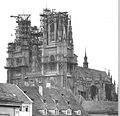Franz Josef von Denzinger
Franz Josef Ritter von Denzinger (born February 24, 1821 in Liège , † February 14, 1894 in Nuremberg ) was a German architect and church builder. His works include numerous churches, u. a. in Regensburg and Frankfurt am Main .
Life
Franz Josef Denzinger was born in Liège as the son of Ignaz Denzinger, a university professor of philosophy, and his wife Marie Thekla, nee. Molitor born. The family moved to Würzburg in 1831 , where the son attended grammar school and then studied "general" sciences at Julius Maximilians University, where his father taught as a full professor. From 1842/43 he studied engineering at the Royal Polytechnic Academy in Munich , as well as architecture at the Academy of Fine Arts . In 1846 he completed his training with the state examination as an engineer for the state construction service for road, bridge and hydraulic engineering, in 1847 supplemented with the examination as an architect for civil engineering.
First he worked for four years as an engineer in Donauwörth , Augsburg, Würzburg, Bad Kissingen, Bad Reichenhall, and Munich. In 1854 he was appointed as a civil engineer to Bamberg , but before taking up the position as a civil engineer he was sent to Regensburg, where he had to appraise and evaluate the spatial use of the Thon-Dittmer-Palais , which was then acquired by the city in 1856 .
Denzinger used the year 1855 for a study trip through the Austrian and German states but also to France, Belgium and Switzerland. In the same year he married Hedwig Magdalena Genofeva von Stefenelli in Regensburg and built a new chemical laboratory in Erlangen in the following years.
Decisive for his career was his appointment as a civil servant at the royal building authorities in Regensburg in 1858 and in the following year the appointment as cathedral master builder in Regensburg by Bishop Ignatius von Senestrey . At the beginning of his term of office, the new bishop had set himself the goal of completing the medieval Regensburg Cathedral by expanding the two cathedral towers. Both King Maximilian II and his father Ludwig I , who abdicated in 1848, urged him to do this, because the cathedral had been the property of the Kingdom of Bavaria since 1810. A cathedral building association was founded to finance the construction. After fierce internal disputes between the state building authorities and the cathedral builder over the existing expansion plans, in which the bishop also vehemently interfered, the expansion of the cathedral towers was achieved under the direction of cathedral builder Denzinger according to his own designs in the years 1860 to 1669, always accompanied by Good wishes from his supporter and benefactor Ludwig I. His wish to see the completion of his cathedral was not fulfilled because he died in 1868. In the years of construction, Denzinger was also busy with expert opinions on other church building projects in Ulm, Würzburg, Mainz, Bremerhaven and Partenkirchen. He had earned a great reputation in specialist circles and had become a member of many supra-regional building and scholarly committees.
After completing the work on the Regensburg cathedral towers, Denzinger was made an honorary citizen of Regensburg in June 1869 and awarded several medals. In 1869 Denzinger moved to Frankfurt am Main, where he managed the reconstruction of the cathedral , which burned down in 1867, as master builder until 1877 , the tower being given its new top according to the plans of the cathedral builder Madern Gerthener in 1415 . During this work, in addition to extensive expert work, he also completed the transept at the Regensburg Cathedral using transept gables and crossing roof turrets. But instead of a crossing tower, according to medieval findings, only a wooden roof turret could be realized, which was clad with zinc sheet.
In 1879 Denzinger returned to the Bavarian civil service, became a government and district building officer in Bayreuth and continued to work extensively in the field of church building. In 1885 he was appointed senior building officer to Munich and retired in 1891. At the end of the civil service he was raised to the personal nobility . On February 14, 1894, Denzinger died unexpectedly of a stroke on a trip as a member of the jury for an architecture competition in Nuremberg. He was buried in the Old Munich North Cemetery.
Meaning and honors
The most important achievements of Denzinger are the completion of the domes in Regensburg and Frankfurt. In October 1897, several local dignitaries founded a memorial committee in Regensburg with the aim of erecting a memorial in Regensburg for the “spiritual hero Denzinger”, the “ingenious creator of the artistic perfection of the mother church of the diocese, our majestic cathedral” . After 13 years of planning, after many unsuccessful searches for locations and designs, a decision was made in favor of a small plaque with a portrait medallion. It was attached to the east outside of the south facade of the cathedral and most Regensburg residents have not noticed it until now because it is very inconspicuous.
Denzinger was regarded as an excellent expert on medieval architecture and was often consulted as an expert on church buildings or renovations. a. at: Ulm Minster , Mainz Cathedral , Katharinenkirche (Oppenheim) , Würzburg Cathedral , Strasbourg Minster , Metz Cathedral .
He received numerous honors, including a.
- Member of the Academy of Fine Arts in Vienna (1868)
- Honorary Citizen of Regensburg (1869)
- Member of the "Commission for the Preservation of Art Monuments and Antiquities in Bavaria" (1869)
- Master of the Free German Hochstift in Frankfurt am Main
- Member of the Scholars' Committee of the Germanic Museum in Nuremberg
He was awarded several medals for his services and personally ennobled on retirement.
- Knight's Cross of the Order of Merit of St. Michael I Class (1869).
- Knight's Cross of the Franz Joseph Order (1871)
- Knight's Cross for the Order of Merit of the Bavarian Crown with Elevation to Personal Nobility (1891)
Works (selection)
- Chemical laboratory of the University of Erlangen (1856-1857)
- Saltworks and salt bath in Kissingen (1858)
- Completion of the Regensburg Cathedral (1859–1872)
- Drafts for the church in Kemnath, built between 1863 and 1864, and for the Catholic church in Hof in Vogtland
- Reconstruction of the Frankfurt Cathedral (1867–1878)
- New construction of the city archive in Frankfurt am Main (1874–1877)
- New construction of the Dreikönigskirche in Frankfurt in neo-Gothic style (1875–1880)
- Renewal of the choir and nave of the parish church St. Jakobus in Leutenbach with Friedrich Kratzer (1884/86; list of monuments )
- Restoration of the collegiate church in Aschaffenburg
- George's Church in Nördlingen
- City parish church in Burghausen
- Renovation of the parish church of St. Valentinus in Kiedrich
- New construction of the church in Hetzles near Erlangen
- Adalberokirche in Würzburg (built from 1894 to 1899 based on Denzinger's drawings in neo-Romanesque style ).
literature
- Julius Hülsen: Denzinger, Franz Josef Ritter von . In: Allgemeine Deutsche Biographie (ADB). Volume 47, Duncker & Humblot, Leipzig 1903, pp. 661-663.
Individual evidence
- ↑ Werner Chrobak: The Thon Dittmer-Palais . In: City of Regensburg, Kulturreferat (Hrsg.): Kulturführer . tape 25 . City of Regensburg, Regensburg 2019, ISBN 978-3-943222-55-5 , p. 67 f .
- ↑ a b c d Martin Dallmeier: The Franz Josef von Denzinger monument in Regensburg. A long way from a memorial idea to a memorial plaque (1897–1910) . In: Negotiations of the historical association for Upper Palatinate and Regensburg . tape 158 . Historical Association for Upper Palatinate and Regensburg, 2018, ISSN 0342-2518 , p. 142-146 .
Web links
| personal data | |
|---|---|
| SURNAME | Denzinger, Franz Josef von |
| ALTERNATIVE NAMES | Denzinger, Franz Josef Ritter von (full name) |
| BRIEF DESCRIPTION | German architect and church builder |
| DATE OF BIRTH | February 24, 1821 |
| PLACE OF BIRTH | Liege , Belgium |
| DATE OF DEATH | February 14, 1894 |
| Place of death | Nuremberg , Germany |





